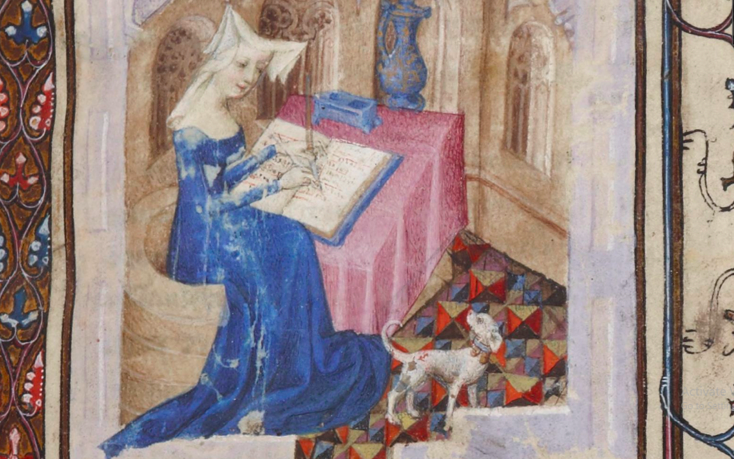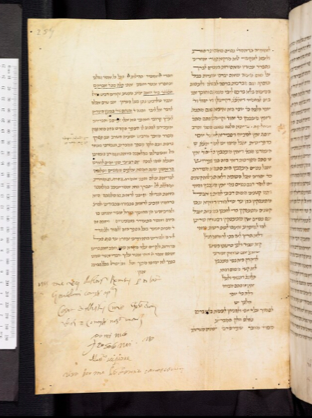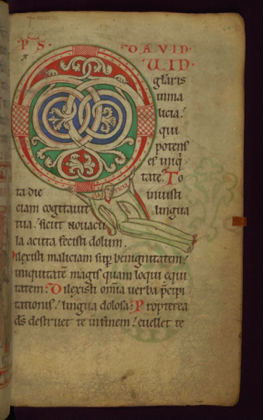by Alison Hudson, University of Central Florida

Image above: Christine de Pizan writing, from a manuscript that contains her autograph (Paris, BnF Français 835, f. 1r).
“Who is your favourite pre-modern, female scribe?” If you were to ask any cataloguer, librarian, curator or scholar of pre-modern writing that question, they would probably have a few interesting examples.
From ancient Mesopotamian scribes like Amat-Mamu to illuminators like Enda to famous poets like Christine de Pizan, female scribes existed in all regions and time periods. Some of the most studied surviving manuscripts and texts—including one of the earliest and most complete Bible manuscripts and the earliest Old English chronicle—have been associated with female scribes at one time or another.
In the past few decades, scholars such as Alison Beach, Diane Watt, Pamela Robinson, Henrike Lähnemann, and Kim Haines-Eitzen—to name just a very few— have made important strides in emphasizing how many pre-modern female scribes existed, and how many texts and manuscripts they helped to transmit and create. Nevertheless, the notion persists that in the ancient and medieval world, “almost all scribes were men”, at least in popular culture and in corners of the internet.
Frustrated by the persistence of the claim that “all scribes were male”, both on Twitter and among some undergraduate students, I thought it would be useful to make a database of known female scribes from the pre-modern period.
This open access resource will direct readers to examples of female scribes and to the studies about female scribes that have been written in the past few decades. It is modelled on recent, inspiring projects that have collected examples of women’s interactions with books beyond scribal contributions, such as the Repertorium of Manuscripts Illuminated by Women in Religious Communities of the Middle Ages and Women’s Literary Culture and the Medieval Canon. I have just launched an extremely low-tech beta version of this database at https://femalescribes.blogspot.com/.
This database consists of two main lists.
The first list covers female scribes’ surviving works. The second notes female scribes mentioned in other sources, such as the inscription mentioning Sciathis Magia, an 18-year-old libraria, or Archbishop Boniface’s letter requesting that Abbess Eadburg “make a copy of St Peter’s epistles written in gold” (“ut mihi cum auro conscribas epistolas domini mei, sancti Petri apostoli”).
How You Can Help
Both of these lists are works in progress.
So far, the lists just contain the first 100 female scribes and references to female scribes that came to my mind, to make the point that female scribes did exist across pre-modern societies. I will expand these lists over the coming weeks, and I am seeking crowd-sourced contributions to expand the list. After all, there are far too many pre-modern female scribes for one person to track down and list them all. This will also permit the database to have as large a geographic and chronological span as possible.
The database contains a field to list the name of the person who proposed a given scribe or manuscript for inclusion, and I would be eager to hear if there are other ways you would like your contribution acknowledged, too. This project has already benefitted hugely from other scholars’ advice. I am particularly grateful to Elaine Treharne and Diane Watt for their comments on the format and content of the lists and their encouragement.

Image above: page containing a colophon that mentions that Pola, daughter of Abraham the scribe, completed copying this book on Wednesday, March 18, 1293 (now Oxford, Bodleian Library, MS. Canonici Or. 89, f .257r).
Why this project?
But why create a list solely of female scribes at all (apart from facilitating arguments on Twitter)?
After all, as Alison Beach and many others have noted, sex and gender do not seem to have inherently affected the quality of scribes’ writing. When men and women write in the same script, there are no consistent differences that can be assigned to gender. Female scribes also copied the same sorts of texts as male scribes.
To identify female scribes, we have to rely on colophons—which appear only in a minority of manuscripts— or arguments about hands which can be linked to other manuscripts with colophons or where the scribe used female forms or pronouns to describe herself or that resemble specific handwriting that was taught at a given institution. Many more manuscripts written by female scribes probably survive than can be securely identified as such today. So, if male and female scribes are so difficult to distinguish, why should we strive to make the distinction?

Image above: Woman labelled as Claricia, swinging from an initial ‘q’ in a Psalter made at the Benedictine convent of Saints Ulrich and Afra in Augsburg (now Walters Art Museum, W.26, f. 64r). Digital image courtesy of the Getty’s Open Content Program.
Moreover, why even use the terms “male” and “female” at a time when European and colonial gender binaries are being dismantled?
Female names that appear in colophons—such as “Ota”— might have been applied to someone who today would be better understood as trans or nonbinary. Indeed, many known scribes were monks, nuns, or other religious leaders whose lifestyles already challenged the gender constructs of their contemporary societies.
Nevertheless, it is still worth thinking about “female” scribes, because “male” and “female” were categories that were enforced in many pre-modern societies. In particular, the religious institutions and contexts in which many pre-modern scribes worked were often (although not always) divided along gendered lines. To better appreciate the surviving sources, it is necessary to understand the contexts in which surviving texts were produced and preserved.
Female scribes and female contexts are particularly worth tracking because earlier scholars omitted to consider female scribes or institutions as possibilities for the production and provenance of manuscripts. This has led to errors, since female scribes did exist and did produce works that survive to this day. This is not, in any way, to deprecate earlier scholars’ contribution to palaeography and manuscript studies. Rather, it is to encourage us to continue their tradition of analysing the manuscripts themselves in light of scholarly developments.
Nineteenth- and early twentieth-century cataloguers’ work still underpins many of assumptions about where manuscripts were made, and these cataloguers assumed that manuscripts were made at male houses. To take just one example, we could consider the number of pre-Conquest English manuscripts that can localized to Winchester. Earlier cataloguers associated these with either the New Minster or the Old Minster, the two major male houses in pre-Conquest Winchester, but not with the Nunnaminster, even though no less a palaeographical giants than Malcolm Parkes showed that groups of manuscripts can be associated with the Nunnaminster’s scribes.
Manuscripts that have at least the potential to be associated with the Nunnaminster include additions to the end of the Book of Nunnaminster, by a scribe who also worked on the earliest sections of the earliest surviving Old English chronicle (the Parker Chronicle, Cambridge, Corpus Christi MS 173) and the oldest known copy of the Old English Orosius (the Tollemache Orosius, London, British Library, Add MS 47967).
Of course, some scholarly hypotheses about which manuscripts can be associated with female scribes are debatable. As noted above, it can be difficult to prove that a manuscript was connected to a female scribe without a colophon or a note of a name at the end of a quire. And sometimes, later notes can be unreliable.
For example, the Codex Alexandrinus—one of the oldest copies of the Bible—was associated with a female scribe, Thecla, in a seventeenth-century Arabic note. Many modern scholars have been sceptical of this attribution, although recently Kim Haines-Eitzen has noted that female scribes were indeed involved in the early transmission of Christian texts.
For the purposes of this project, such possibilities will be noted, albeit highlighted to indicate doubt. Nevertheless, it is important to acknowledge these possibilities, because in doing so, our analyses have the possibility of becoming more accurate and more useful. When we do not automatically assume an ornate manuscript “must have” been made in a male context, when we say “at least” one scribe was female, rather than “only” one scribe was known to be female, we are better reflecting the realities of pre-modern text production.
So, who is your favourite pre-modern, female scribe? If you do not have one yet, you can find a long list to choose from at https://femalescribes.blogspot.com/. If you do have one who is not yet included on the lists, please send her details through.
